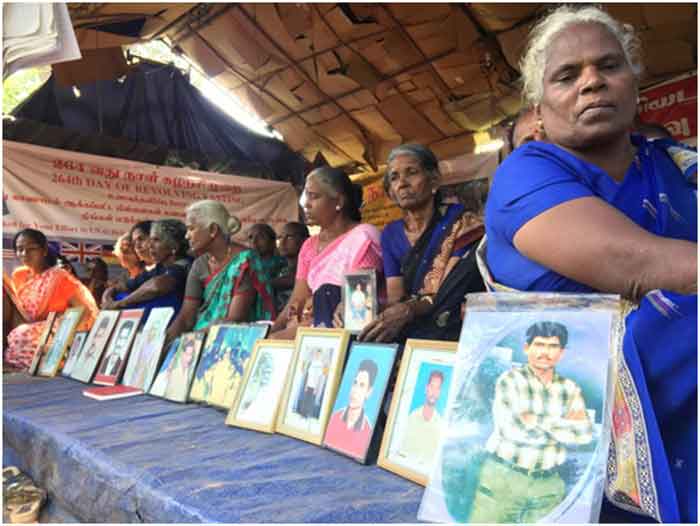
The Tamil homeland has been subjected to decades of Sinhalisation but since the end of the armed conflict, there has been a rise in the establishment of Buddhist temples and Sinhala settlements through the appropriation of Tamil land. The government has used it’s departments such as the archaeological and land survey departments to alter the demographics of the North-East.
Rise of Buddhist Nationalism Leading up to Sri Lanka’s independence, “Buddhism and Sinhalese were so closely intertwined that it became impossible to treat either in isolation.” The GoSL “constantly and deliberately targeted the Tamil language, land, culture, education, economy, history and identity, while promoting and protecting Sinhala language, land, culture, education, economy, history and identity.” Though this section does not delve into the origins of Sinhala Buddhist ideology, it demonstrates the way Buddhism informs the basis for Sinhalization while also functioning as a powerful working strategy in the state-sponsored Sinhalization of the North-East.
According to the Sri Lankan Constitution of 1972, “The Republic of Sri Lanka shall give to Buddhism the foremost place and accordingly it shall be the duty of the state to protect and foster the Buddha Sasana.” This article remains unchanged to this day.
The first Executive President of Sri Lanka, the late J.R. Jayawardena, said publicly that “seventy percent of our country are Buddhists. Therefore, we shall lead our lives according to the sacred words of Buddha… We have a duty to protect the Buddha sasana and to pledge that every possible action would be taken to develop it.”
This sentiment prevails. At a religious ceremony on January 2, 2022, the current president, Gotabaya Rajapaksa,said: On the day I was sworn-in as the country’s President at the Ruwanweli Seya, I declared that I was a President elected by the majority of Sinhalese. I firmly believe that the protection of Sinhala Buddhists, who have made so many sacrifices to elect me as the first citizen of this country and that heritage is my foremost responsibility. Notably, President Rajapaksa, who himself is accused of participating in war crimes, crimes against humanity, and genocide when he served as Defense Minister during the end of the armed conflict in Sri Lanka, further strengthened the powers of the executive presidency in his first year in office. On October 22, 2020, the Sri Lankan Cabinet passed the 20 th Amendment to the Constitution, which concentrated powers with the President and provided him with the power to make important political appointments without checks and balances. As will be seen throughout this report, the President uses his extensive powers to harden Sinhala-Buddhist nationalism in Sri Lanka and to promote the process of Sinhalization.
Sinhalese colonization of Tamil districts was willfully carried out to change the ethnic and political character of Tamil areas.It is estimated that almost a quarter of the island’s population was moved from the Wet Zone to the Dry Zone between 1946 and 1971, under peasant colonization schemes. These colonization schemes altered the ethnic composition of Tamil provinces. In particular, Sinhalese population in the Trincomalee District increased from 3.8% to 33.6% of the total population between 1911 and 1981. During the same period, the Tamil population decreased from 56.8% to 33.7% in the district. In the Amparai District, Sinhalese population increased from 7.0% to 38%, while the Tamil population declined from 37.0% to 20.0% between 1911 and 1981. This rapid increase in the number of Sinhalese settlers in the Eastern Province led to the creation of the Sinhalese electorates of Seruvila and Amparai in 1976.
Since independence in 1948, the GoSL has tried to weaken (or outright deny) the concept of the “Tamil homeland” by engaging in processes of demographic change and repression through the three strategies that advance Sinhalization: land acquisition, militarization, and Buddhisization. Using these methods, the GoSL also seeks to strengthen a Sri Lankan identity, rooted in Sinhala-Buddhism (with a foremost place for Sinhala-Buddhists), including by assimilating Tamils and minority groups into this monolithic identity.
The governance, management and use of “heritage lands” are at the heart of many intergroup tensions in Sri Lanka. While the GoSL has designated several bodies to oversee the designation, use, and protection of such lands, these mechanisms are largely headed and captured by Sinhalese-Buddhist interests, with little representation or consultation with Tamil and minority groups. As a result, Tamils and Muslims in the Northern and Eastern Provinces have been systematically marginalized while their religious sites are co-opted or destroyed. Sinhala Buddhist nationalism is currently utilized by the state to justify Buddhisization across the North-East. The GoSL undertakes this Buddhisization by: destroying and appropriating non-Buddhist places of worship (such as Hindu temples and Muslim mosques), constructing Buddhist viharas and statues in majority Tamil-speaking areas with military sponsorship, providing space and authority for Buddhist monks to influence the agenda of GoSL, and using the archaeological department and Presidential Task Force as instruments to selectively uncover new areas with Buddhist history and legitimize state-sponsored Sinhalization in the North-East.
Kumarathasan Rasingam – Secretary, Tamil Canadian Elders for Human Rights Organization.













































